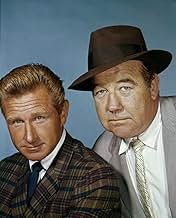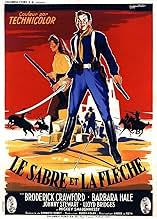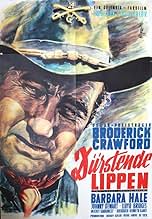Aggiungi una trama nella tua linguaThe remnants of a massacred cavalry troop and ragtag group of stagecoach passengers fight for survival against fierce Comanches at a desert ruin.The remnants of a massacred cavalry troop and ragtag group of stagecoach passengers fight for survival against fierce Comanches at a desert ruin.The remnants of a massacred cavalry troop and ragtag group of stagecoach passengers fight for survival against fierce Comanches at a desert ruin.
- Pete
- (non citato nei titoli originali)
- Lt. Floyd
- (non citato nei titoli originali)
- Munitions Man
- (non citato nei titoli originali)
- Wagon Driver
- (non citato nei titoli originali)
- Indian
- (non citato nei titoli originali)
Recensioni in evidenza
They and the Germans are greatly in need of water. The..."trade a rifle for a cup of water... two rifles, two cups of water" is the same in both.... still fun to watch. It's fun to match the characters and the similarities. Sahara (1943) is a very, very good WWI movie.... Last of the Comanches (1952) is a so-so Western.
Safe as a bomb shelter Western. A remake of Zoltan Korda/Humphrey Bogart's war movie "Sahara" from 1943, Last of the Comanches finds Broderick Crawford as the leader of what remains of a massacred cavalry troop. As they make their way across the desert they pick up ragtag group of stagecoach passengers and as water runs low, they must fight for survival against fierce Comanches led by Black Cloud.
In essence it's a survivalist story with some Indian War action dotted around the outskirts of plotting. It's nice and airy, pleasingly performed, easy on the eye with its Technicolor photography, and De Toth once again shows himself to be a good marshall of action scenes. Crawford carries the movie of course, imbuing Sergeant Trainor with fearless bluster that holds the dysfunctional group together. The narrative strength comes from the lack of water, both for the whiteys and the Comanche, where the often forgotten weapons of war, that of food or drink, firmly keeps the story engrossing.
Not as good as "Sahara" but still a safe recommendation to Western and Brod Crawford fans. 7/10
Gritty and decently written Western , exploring the anguish of soldiers and stagecoach passengers , and the hard relationship among them. This is a moving story about people surrounded and continuously harassed by Indians and other dangers . Make a thousand double bill Westerns and you must come up with one little gem . Director here and there puts every trick and action enough . Stars Broderick Crawford who gives a nice acting as a two-fisted Cavalry Sergeant commanding a ragtag team. He leads a parade of interpretations that make the characters live. The remmant cast are pretty good with plenty of notorious actors and other secondaries, such as : Barbara Hale, Lloyd Bridges, Mickey Shaughnessy, George Mathews, Chubby Johnson , Martin Milner and brief appearance uncredited of Steve Forrest.
It displays a thrilling and evocative musical score by George Duning. Furthermore, brilliant and picturesque photography by cameramen Charles Laughton and Ray Cory. The motion picture was well directed by Andre De Toth .At his beginning, De Toth entered the Hungarian film industry , getting work as a writer, editor, second unit director and actor before eventually becoming a filmmaker. Later on, Alexander Korda gave him a job in England, then Toth emigrated to the US in 1942 and started working as a second unit director in Jungle Book 1942. Andre De Toth was a skillful artisan, who made all kinds of genres as : Adventure : The Mongols , Morgan the pirate, Tanganyka. Peplum: Gold for the Caesar. Terror : House of Wax 1953, probably his best and most known film. And Westerns : Indian Fighter, Man in the saddle, Ramrod, The stranger wore a gun, Last of the Comanches . Rating : 6.5, well worthwatching. Essential and fundamental seeing for Western enthusiasts.
Lo sapevi?
- QuizA remake of Sahara (1943), in which Lloyd Bridges also co-starred.
- BlooperThe last shot shows a hat with a 'crossed sabers' badge, with a '14' above and a 'G' below the sabers. The number represents the number of the cavalry regiment. However, the USA had only 10 cavalry regiments during this period.
- Citazioni
Black Cloud: I am Black Cloud.
Sgt. Matt Trainor: That figures.
Black Cloud: Black Cloud come to make peace talk.
Sgt. Matt Trainor: [Sarcastically] I didn't think you came here to make jokes. What's on your mind?
Black Cloud: Black Cloud mighty chief... greatest of all! His warriors are many...
Sgt. Matt Trainor: [Interrupting] Soon as you're finished patting yourself on the back, let's get down to cases. What's the deal?
- Curiosità sui creditiOpening credits prologue: The Indian tribes of the southwest were at peace, except for the notorious renegade Comanche chieftain,Black Cloud, and his savage followers.
For three years his raids and massacres threatened the security of the new peace.
On August 27th, 1876, a cavalry scouting patrol, out from Fort Macklin seeking Black Cloud, stopped for water at the little town of Dry Buttes.
Here, Black Cloud trapped them...
- ConnessioniFeatured in History Buffs: Dances with Wolves (2017)
- Colonne sonoreShoo, Fly, Don't Bother Me
(uncredited)
Attributed to Thomas Brigham Bishop
Sung, with additional lyrics, by the soldiers at the Mission
I più visti
- How long is Last of the Comanches?Powered by Alexa
Dettagli
- Tempo di esecuzione1 ora 25 minuti
- Proporzioni
- 1.37 : 1
Contribuisci a questa pagina






































